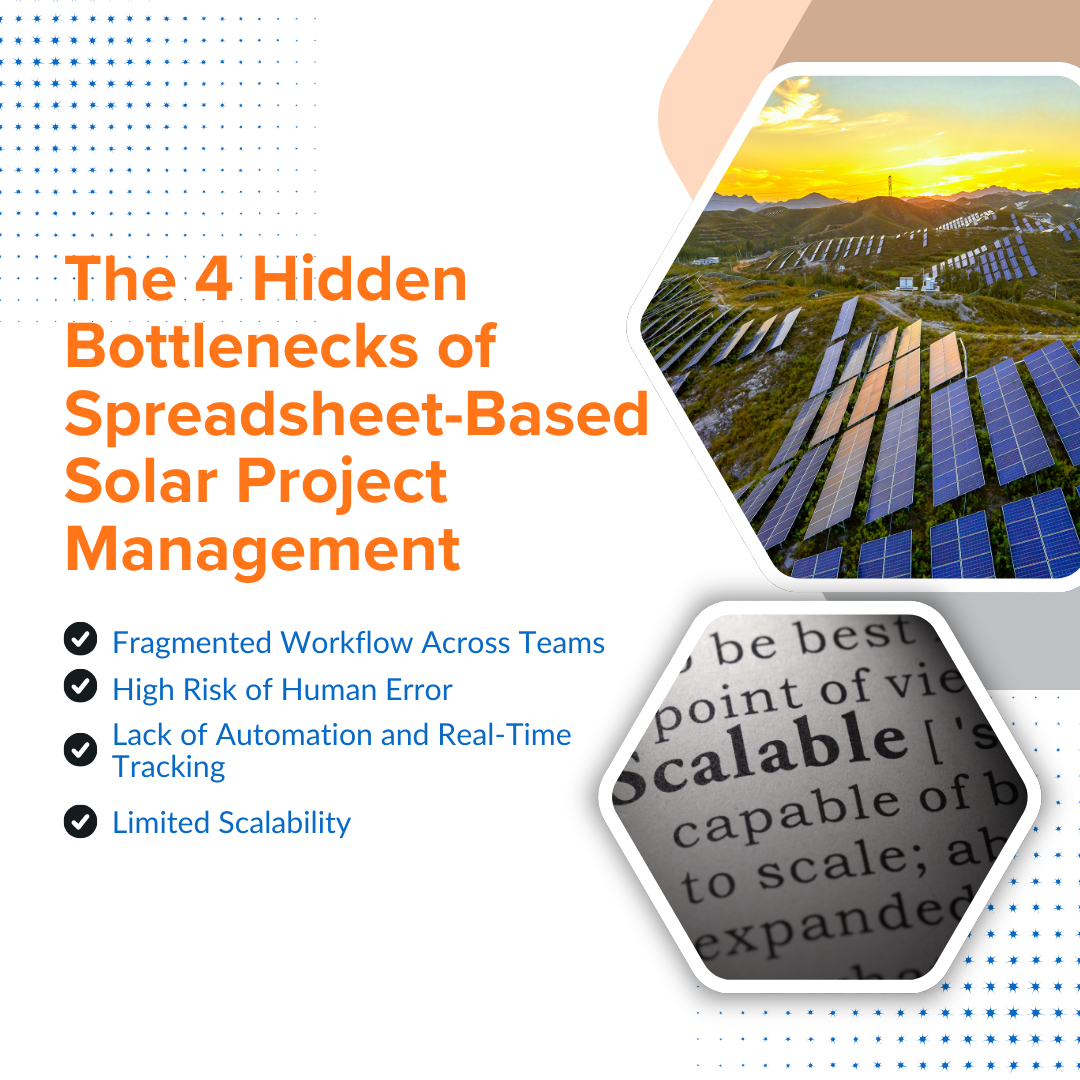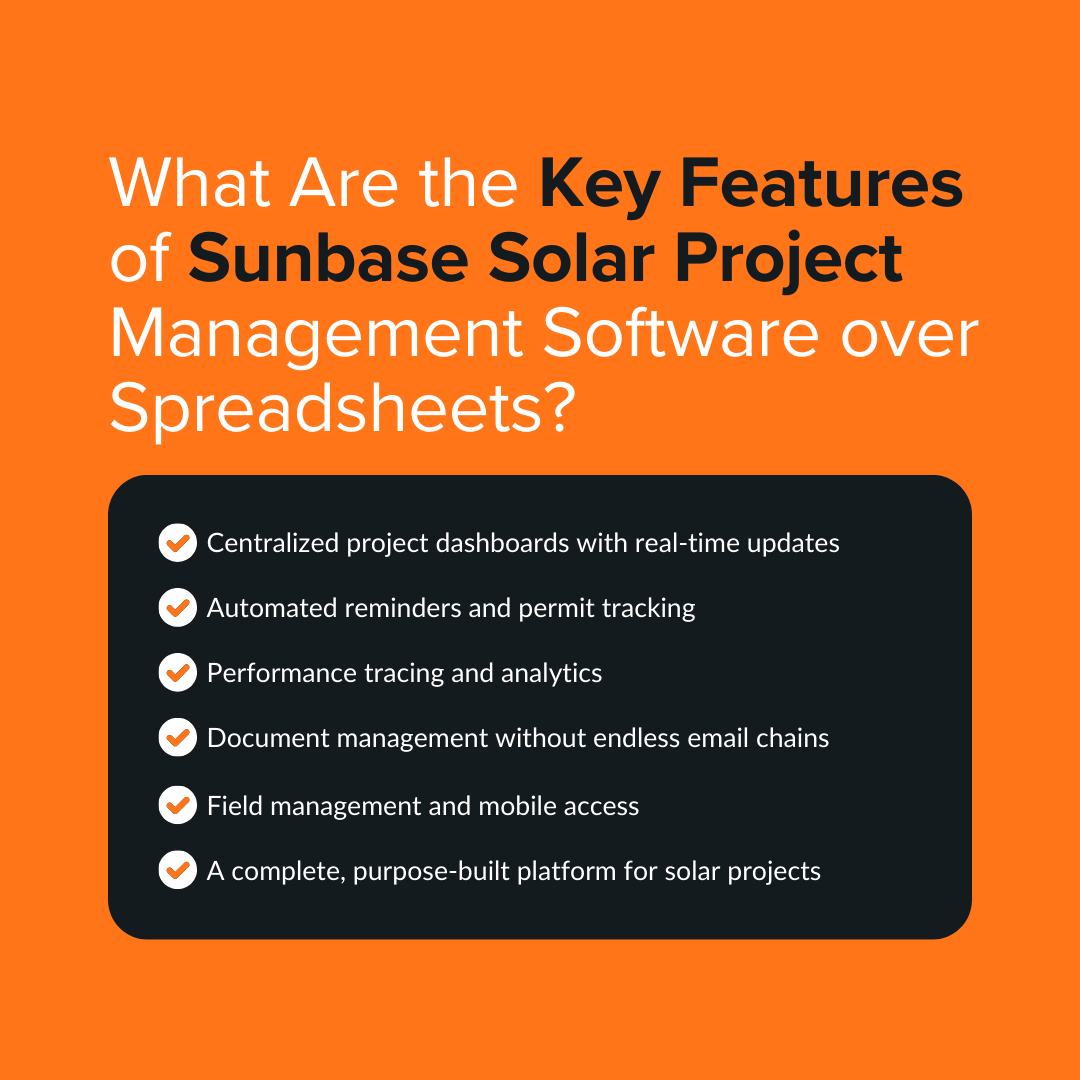September 1, 2025
Audio overview: Listen & Learn
Many solar businesses today still rely on spreadsheets as their tracking tool, and they are drawn towards Excel due to its low cost and flexibility.
Microsoft Excel has been the go-to spreadsheet tool for years for managing proposals, procurement, permits, and installation, but as the solar industry grows, so does the limitations of solar project management.
From human errors to fragmented communication, spreadsheets like Excel can slow down even the most experienced of teams. Today, more and more companies are looking for Excel alternatives that are built solely for solar industry projects.
Modern software like Sunbase, that are built for solar projects, can enable businesses to reduce delays, cut costs, and deliver better service. So, let's check out why solar companies are trying to move beyond Excel for their operations.
Why Solar Teams Are Replacing Excel with All-in-One Software
Many solar teams start with spreadsheets because they’re simple and familiar, but as projects get bigger, the cracks start to show.
Keeping track of permits, designs, and installation updates across scattered Excel files often means missed deadlines, duplicated work, and costly mistakes.
On the other hand, software tools bring everything together in one place: real-time updates, automated reminders, and seamless collaboration across departments.
Moving beyond Excel isn’t about giving up flexibility; it’s about gaining clarity, control, and the freedom to grow without the bottlenecks.
Key Takeaways
- Spreadsheets can’t keep up with modern solar project demands; Sunbase offers real-time tracking, automation, and centralized document management built for solar workflows.
- Modern solar project management platforms reduce errors, speed up installations, and provide data insights that help businesses scale more efficiently.
- The future of solar workflows includes AI-driven scheduling, predictive analytics, and deeper integration with design, inventory, and financial tools for smarter, proactive management.
Why do solar companies use spreadsheets as their tracking tool?
For solar businesses, using spreadsheets for data tracking has become the norm for projects. And here's why:
- Flexibility: Teams can easily customize the trackers as per their needs, so they can be easily tailored to the different parts of the solar workflow, from sales lead and their follow-ups to installation schedules.
- Low Cost and Universal Access: Almost everyone knows how to use Excel, and it can be used by anyone, anytime, anywhere, for solar projects. There is no need for expensive licenses and complex onboarding processes.
- Simple Setup: New trackers can be created within minutes by solar project managers without waiting for an IT team or software rollouts.
Such advantages help spreadsheets remain popular, but as solar project development processes improve, the spreadsheets that once felt simpler can turn into a bottleneck for operations to continue. Real-time monitoring tools are essential for maintaining efficiency and productivity in solar installations.
Why do solar companies rely on Microsoft Excel as their go-to tool for solar workflows?
Microsoft Excel is often used in the solar industry because it's familiar, powerful, affordable, and easy to share.
Advanced features like pivot tables, V-LOOKUP, X-LOOKUP, graphs, charts, and conditional formatting can fit the complex solar workflows in the renewable energy industry.
Almost everyone is familiar with and quick with Microsoft Excel, making it an efficient tracking tool.
Project files can also be easily shared across teams and devices, but as the project scope and scale increase, many businesses prefer to move towards Excel alternatives built specifically for solar.
Does your solar business still depend on Excel for proposal generation? Check out Why Every Solar Business Needs a Proposal Tool (Even if You Use Excel)
The 4 Hidden Bottlenecks of Spreadsheet-Based Solar Project Management

Spreadsheets remain an efficient tool for solar projects, but they often hide the operational bottlenecks that may slow down team progress.
1. Fragmented Workflow Across Teams
In most solar companies, sales, engineering, operations, procurement, and installation teams use separate files to track parts of their processes. Not compiling data properly can create blind spots, duplicate work, and wasted hours, weakening the workflow.
2. High Risk of Human Error
Manual data entry results in mistakes in copy-paste, and outdated file versions can lead to critical errors like
incorrect system design, scheduling conflicts, and costly budget overruns that impact consumer trust and profitability.
3. Lack of Automation and Real-Time Tracking
Spreadsheets act as passive tracking tools that can automatically alert teams to delayed approvals or shifting timelines. Important tasks can slip through the cracks, creating problems that would be easily avoidable with automated solar tools.
4. Limited Scalability
As the solar project scope increases, for example, a system that is fine for five projects can become a burden when managing fifty or more. As teams grow, the work of admins increases faster than the revenue, making it hard to deliver solar projects on time and at scale.
Such hidden challenges show why forward-thinking businesses in the renewable energy industry are looking to explore dedicated Excel alternatives. The alternatives are essential in replacing the manual, reactive spreadsheets with proactive, connected, and scalable solar project management.
What Should Businesses Look for in an Excel
Alternative for their Solar Energy Projects?
As projects become more complex, switching from spreadsheets to dedicated project management software isn't about adopting new systems, but rather finding the right fit for your solar firm to improve the efficiency of resources.
Here's what to look for when exploring Excel alternatives:
1. Purpose-built for Solar workflows
Choosing an integrated platform designed specifically around how solar teams operate, from lead-tracking to installation of solar panels, rather than a generic tracking tool, is essential.
2. Automation and Visibility
Look for automated alerts, centralized dashboards, and real-time updates that keep everyone aligned and increase efficiency in the distribution of solar energy in a timely manner.
3. Secure document management
A system that safely stores and organizes contracts, designs, and permits can enable teams to work at peak performance.
4. Scalability to handle complex projects
As your business in the renewable energy industry grows from a few projects to dozens, the right platform can handle the volume and other technical aspects more seamlessly.
Finding the right spreadsheet software for your solar projects can free up time and resources for smarter, sustainable growth.
How Does Sunbase Transform the Solar Workflow?
Imagine running your entire solar business on a single, purpose-built platform instead of scattered spreadsheets.
That’s what Sunbase brings to the table, transforming day-to-day workflows into something smoother, faster, and far more reliable.
Sunbase transforms the entire solar workflow, bringing clarity, speed, and collaboration to every stage of a solar project. Here is how it makes a difference:
1. Real-time connected project tracking:
With Sunbase at every stage, from first sales leads to the last solar panel installation, teams no longer rely on manual updates or outdated spreadsheets, so everyone stays on the same page without any extra effort.
2. Seamless collaboration across departments:
Sales, design, regulatory compliance, and installation can work together on a single platform. For example, when the design team finishes a system layout, the installation team is notified immediately to reduce costs, delays, and manage projects efficiently.
3. Complete visibility for solar project managers:
Solar project managers get a clear view of each project, such as its status, upcoming tasks, and potential risks. It helps in quickly finding and solving issues in operations, reassigning resources, and keeping projects on track.
A must-read to understand how Solar CRM Software Can Help You Win More Projects
What Are the Key Features of Sunbase Solar Project Management Software over Spreadsheets? Why is it more than just an Excel alternative?

Spreadsheets have long been a go-to tool for tracking and managing solar projects, although Sunbase offers a modern, all-in-one platform that is built specifically for the needs of the solar energy industry.
Here's why Sunbase is a complete replacement for Excel during the solar project development process:
> Centralized project dashboards with real-time updates
Sunbase brings all project data into one live dashboard. Due to this, every solar project manager can instantly see what is happening throughout the process and if operations are carried out efficiently or not.
> Automated reminders and Inventory Management
Keeping track of permits and deadlines can lead to costly delays. The Sunbase software automatically sends reminders for pending approvals and upcoming milestones, helping teams to stay informed about the project
progress and avoid last-minute surprises.
Moreover, the inventory management feature helps solar businesses track equipment, panels, and components across multiple projects with ease.
> Performance tracing and analytics
Sunbase provides rich analytics and performance insights. Teams can analyze the detailed project plans and timelines, detect delay patterns, determine whether all key steps are followed, and optimize efficiency with data-informed insights.
> Document management without endless email chains
All contracts, designs, and compliance documents are safely stored in a single location. Rather than emailing files back and forth or digging through folders, teams can upload, share, ensure that relevant regulations are followed, and get to what they need quickly and securely.
> Field management and mobile access:
Sunbase’s mobile-friendly tools enable field teams to snap photos, report project status, and communicate in real-time from solar panel installation sites. This keeps people — and office teams — completely connected, even on the move.
A complete, purpose-built platform for solar projects:
Sunbase is a purpose-built solution around the full solar project lifecycle. From lead and resource management to system design, permitting, installation, and service — it’s all simplified in one platform for solar businesses in the renewable energy industry.
In short, Sunbase helps solar companies replace manual spreadsheets with a unified, automated system, improving visibility, collaboration, and overall project delivery.
How do the Modern Solar Project Management Platforms Drive Business Growth?

Today, solar project management platforms like Sunbase allow solar companies to scale by simplifying workflows and solar systems proposals through to installation.
1. Keeps you on your toes
Real-time dashboards and automated updates minimize lags, keeping teams in sync without endless emails and manual data entry.
2. Eliminate expensive errors and delays
Automated reminders keep permits and approvals on track, while centralized document storage makes contracts and designs a breeze to locate, so more installations go smoothly and are more predictable.
3. Data-Driven Decision Making to lead you to the right track
Solar project management platforms show data and analytics that help find out when bottlenecks are hindering the quality of work and how teams are performing. This assists solar project managers in planning more intelligently about decisions and resources.
All-in-One Solar Platform
By swapping spreadsheets for a single connected platform, solar companies can drive more projects across the finish line without sacrificing quality or speed. Scaling is sane.
Solar management software in 2025 doesn’t just capture data — it enables companies to complete projects more quickly, reduce expenses, and remain competitive in an expanding renewable energy resource market.
Check out this step-by-step guide if you have any problems with integrating solar software into your workflow!
What Is the Future of Solar Project Development and Workflows?
The future of solar workflows is intelligent AI tools that do more than just task tracking. AI-assisted scheduling helps predict delays and suggest real-time adjustments, and automated risk detection could flag potential issues before they impact timelines.
Even deeper links with inventory, design, and financial tools will keep projects, budgets, and supply chains aligned effortlessly. Predictive analytics will inform smarter resource allocation, assisting teams to prioritize high-impact work and minimize bottlenecks.
Taken together, these innovations will turn solar project management from reactive coordination into proactive, data-driven decision-making. This will be faster, more efficient, and infinitely more scalable.
Summing It Up
In short, switching from spreadsheets to purpose-built platforms like Sunbase enables solar businesses to work faster, reduce errors, and scale confidently.
With real-time dashboards, automation, and AI-driven insights, modern solar project management transforms daily operations into streamlined, data-driven workflows built for today’s growing renewable energy market.
About Sunbase
Effortlessly oversee everything from lead generation to installation tracking.
Set up in minutes, win deals for years. Sunbase Solar Project Management Software is the ultimate spreadsheet software that you need for your business! Contact us here!
Frequently Asked Questions (FAQs)
Q1: Why should solar companies move from Excel to a dedicated project management platform?
While Excel offers flexibility and low cost, it can’t handle complex solar workflows at scale. Dedicated platforms like Sunbase reduce errors, improve team collaboration, and provide real-time visibility, helping solar businesses deliver projects faster and grow sustainably.
Q2: What makes Sunbase different from generic project management tools?
Sunbase is built specifically for the solar industry. It integrates lead tracking, design, permits, installation, and service in one place, offers automated reminders, mobile field tools, and performance analytics, all designed around the full solar project lifecycle.
Q3: Can solar management tools help with compliance and reporting?
Yes, modern tools include built-in compliance tracking and reporting features, reducing the burden of manual record-keeping.
Q4: How does reporting differ between Excel and dedicated tools?
Software generates real-time reports with charts and KPIs, eliminating the need for manual data entry and formula building.
I agree to receive marketing messaging from Sunbase at the phone number provided above. I understand data rates will apply, and can reply STOP to OPT OUT.







